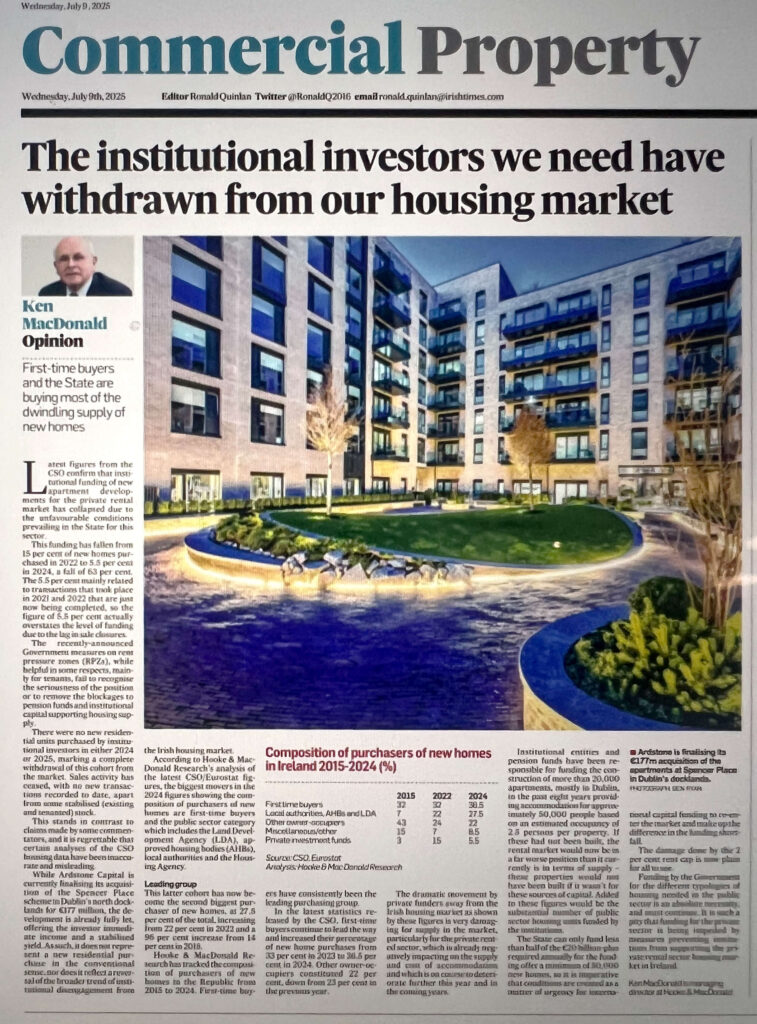
In today’s The Irish Times Commercial Property supplement, Ken MacDonald, Managing Director of Hooke & MacDonald , provides his outlook and latest analysis in The Irish Times and reveals a stark reality: institutional funders have pulled back from the Irish housing industry over the last 3 years, just when funding is most urgent
First-time buyers and the State are buying most of the Republic’s dwindling supply of new homes
Latest figures from the CSO confirm that institutional funding of new apartment developments for the private rental market has collapsed due to the unfavourable conditions prevailing in the State for this sector. This funding has fallen from 15 per cent of new homes purchased in 2022 to 5.5 per cent in 2024, a fall of 63 per cent. The 5.5 per cent mainly related to transactions that took place in 2021 and 2022 that are just now being completed, so the figure of 5.5 per cent actually overstates the level of funding due to the lag in sale closures.

The recently announced Government measures on rent pressure zones (RPZs), while helpful in some respects, mainly for tenants, fail to recognise the seriousness of the position or to remove the blockages to pension funds and institutional capital supporting housing supply.
There were no new residential units purchased by institutional investors in either 2024 or 2025, marking a complete withdrawal of this cohort from the market. Sales activity has ceased, with no new transactions recorded to date, apart from some stabilised (existing and tenanted) stock. This stands in contrast to claims made by some commentators, and it is regrettable that certain analyses of the CSO housing data have been inaccurate and misleading.
While Ardstone Capital is currently finalising its acquisition of the Spencer Place scheme in Dublin’s north docklands for €177 million, the development is already fully let, offering the investor immediate income and a stabilised yield. As such, it does not represent a new residential purchase in the conventional sense, nor does it reflect a reversal of the broader trend of institutional disengagement from the Irish housing market.
According to Hooke & MacDonald Research analysis of the latest CSO/Eurostat figures, the biggest movers in the 2024 figures showing the composition of purchasers of new homes are first-time buyers and the public sector category which includes the Land Development Agency (LDA), approved housing bodies (AHBs), local authorities and the Housing Agency; this latter cohort has now become the second biggest purchaser of new homes, at 27.5 per cent of the total, increasing from 22 per cent in 2022 and a 96 per cent increase from 14 per cent in 2018.
Hooke & MacDonald Research has tracked the composition of purchasers of new homes in the Republic from 2015 to 2024. First-time buyers have consistently been the leading purchasing group. In the latest statistics released by the CSO, first-time buyers continue to lead the way and increased their percentage of new home purchases from 33 per cent in 2023 to 36.5 per cent in 2024. Other owner-occupiers constituted 22 per cent, down from 23 per cent in the previous year.
The dramatic movement by private funders away from the Irish housing market as shown by these figures is very damaging for supply in the market and particularly for the private rented sector, which is already negatively impacting on the supply and cost of accommodation and which is on course to deteriorate further this year and in the coming years.
Institutional entities/pension funds have been responsible for funding the construction of more than 20,000 apartments, mostly in Dublin, in the past eight years providing accommodation for approximately 50,000 people based on an estimated occupancy of 2.5 persons per property. If these had not been built the rental market would now be in a far worse position than it currently is in terms of supply – these properties would not have been built if it wasn’t for these sources of capital. Added to these figures would be the substantial number of public-sector housing units funded by the institutions.
The State can only fund less than half of the €20 billion-plus required annually for the funding offer a minimum of 50,000 new homes so it is imperative that conditions are created as a matter of urgency for international capital funding to re-enter the market and make up the difference in the funding shortfall. The damage done by the 2 per cent rent cap is now plain to see.
Funding by the Government for the different typologies of housing needed in the public sector is an absolute necessity and must continue. It is such a pity that funding for the private sector is being impeded by measures preventing institutions from supporting the private rental sector housing market in Ireland.
Source : The Irish Times